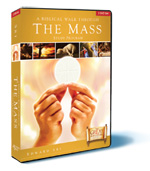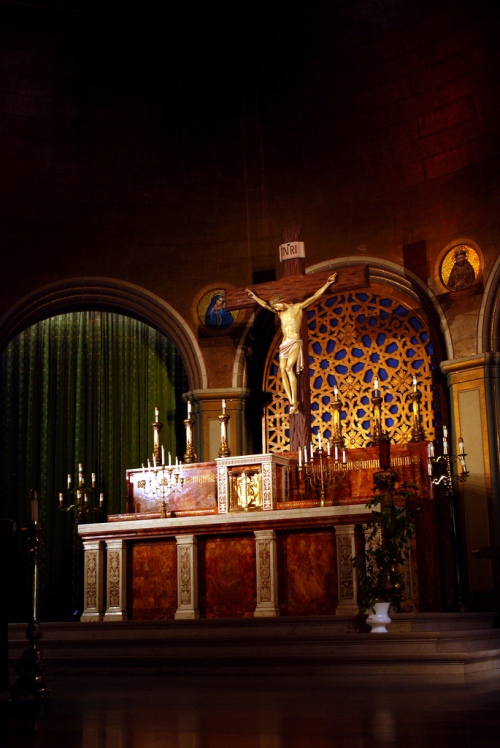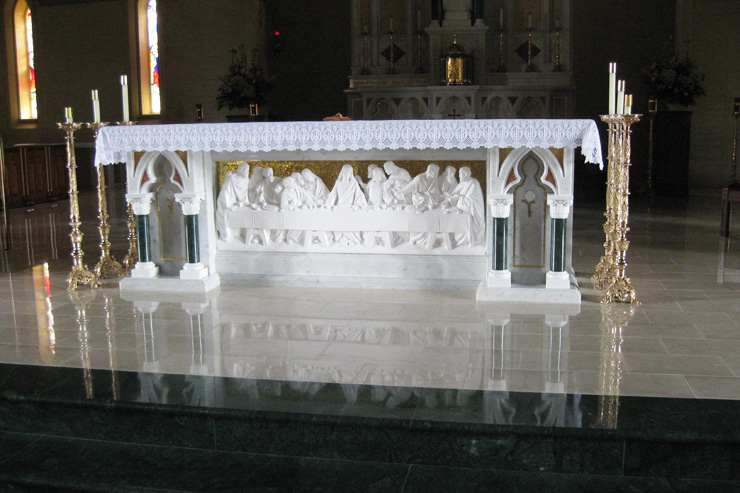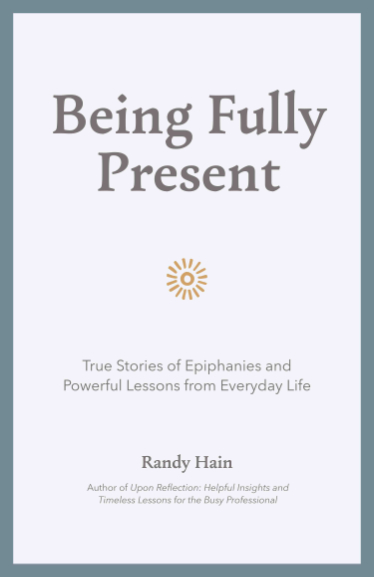A Biblical Walk Through the Mass — Your Moment in the Mass: “For All or Many” and “The Supper of the Lamb”
A continuing series on the Scriptural roots and inspiration of the Holy Mass by Dr. Edward Sri
For All or for Many
Of all the changes in the new Mass translation, two words which will be used by the priest at the consecration have evoked the most questions. Those two words are “for many.”
Currently, the priest has been referring to Jesus’ blood having redemptive value “for all”:
“…this is the cup of my blood, the blood of the new and everlasting covenant. It will be shed for you and for all for the forgiveness of sins…”
But the new translation of the Mass being promulgated on November 27 replaces the words “for all” with “for many”.
Some have raised concerns that the words “for many” limit the universal scope of Jesus’ saving mission. They hold that the new wording gives the impression that Jesus did not die on the cross for everyone — that he offered his blood on Calvary not “for all” but just for a select group of people, “for many.” This is a misunderstanding of the text.
First, this new translation remains closer to Jesus’ actual words from the Last Supper accounts in the Gospels. Jesus said that his blood was shed “for many” (see Matthew 26:28). It is also more harmonious with the Latin text of the Mass and with wording that has been used in the liturgy for centuries.
Most of all, this new translation points to the reality that, although Jesus died for all, not everyone chooses to accept this gift. Each individual must choose to welcome the gift of salvation in Christ and live according to that grace, so that he or she may be among “the many” that are described in this text.
A number of Scripture scholars have observed that Jesus’ language at the Last Supper about his blood being poured out “for many” recalls “the many” that are three times mentioned in Isaiah 53:11-12. In this prophecy, Isaiah foretold that God one day would send his servant who would make himself “an offering for sin,” bearing the sin of “many” and making “many” righteous (Isaiah 53:10-12). Jesus, by speaking at the Last Supper about his own blood being poured out “for many,” was associating himself with this “suffering servant” figure prophesied by Isaiah. Jesus is the one who offers his life for the “many.”
This should not be understood in opposition to the fact that Jesus died “for all” (1 Timothy 2:6). The other prophecies in Isaiah about the Servant of the Lord make clear that he has a universal mission, one that announces salvation to all humanity (see, for example, Isaiah 42:1-10, 49:6, 52:10). In this context, the expression “the many” can be seen as contrasting the one person who dies — the Lord’s Servant (Jesus) — with the many who benefit from his atoning sacrifice.
Let us briefly consider one other change in the translation of the words of consecration: “This is the cup of my Blood” will become “This is the chalice of my Blood.”
While the previous translation of the Words of Institution referred to the “cup” of Christ’s blood, the new translation renders it “chalice.” This is a more accurate and more formal rendering of the Latin text of the Mass and one that underscores the liturgical nature of this vessel. This is no ordinary cup, but the Eucharistic cup (see Luke 22:20; 1 Corinthians 11:25ff.) that the Lord consecrated at the Last Supper. This most sacred of vessels has traditionally been called a “chalice,” and this is the term used in the new translation.
The Supper of the Lamb
 A few beautiful changes have been made to the translation of the prayer that comes shortly before Holy Communion is distributed.
A few beautiful changes have been made to the translation of the prayer that comes shortly before Holy Communion is distributed.
The priest has been saying, “Happy are those who are called to his supper” as he held up the Eucharistic host. But the new translation of this prayer is more robust. The priest will say, “Blessed are those who are called to the supper of the Lamb.”
These new words certainly command our attention. And they underscore how the Eucharist is no ordinary meal, for they recall a climactic moment in the book of Revelation when Jesus comes to unite himself to his people in a great heavenly wedding feast.
In this scene, Jesus Christ, the Lamb of God, is depicted as a bridegroom joining himself to his bride, the Church. An angel announces this loving union by saying, “Blessed are those who are invited to the marriage supper of the Lamb” (Revelation 19:9). In the new translation, the priest at Mass more clearly echoes this angelic invitation to the heavenly wedding feast.
When you hear these words in the liturgy, therefore, you should realize that you are, in a sense, receiving a wedding invitation! And at this great marriage feast, you are no ordinary guest. When you come down the aisle to receive Holy Communion, you come as the bride, as a member of the Church. And you come to be united with your divine Bridegroom who gives Himself to you in the most intimate way possible here on earth — in the Holy Eucharist.
Here, we see how the Eucharist involves an intimate, loving communion with our Lord Jesus — one that is likened to the union shared between a husband and wife. Indeed, Holy Communion is a participation in that heavenly wedding supper of the Lamb, which celebrates the union of the divine bridegroom, Jesus, with his bride, the Church.
Amazing the Son of God
In response to this invitation, we will no longer say, “Lord, I am not worthy to receive to you.” Instead, we will say, “Lord, I am not worthy that you should enter under my roof.”
These new words recall the humility and trust of the Roman centurion in the gospels who asked Jesus to heal his servant who was at his house, paralyzed and in distress. As a Gentile, outside of God’s covenant, and a Roman officer in charge of a hundred soldiers who were oppressing God’s people, this centurion humbly recognizes his sinful condition and his unfavorable position among the Jews. He acknowledges that he — as a gentile, a Roman and a centurion—is not worthy to have Jesus, the holy Jewish rabbi, come to his home: “Lord, I am not worthy to have you come under my roof.”
Yet the Roman Centurion also expresses a great faith that surpasses that of many others in the gospels and amazes even Jesus, which says a lot. (After all, it must take a lot to amaze the Son of God!) Even though up to this point in the gospels, Jesus has only performed healings for people in his presence, this Roman centurion believes Jesus can heal from afar — a long distance miracle — simply by speaking his word: “But only say the word, and my servant shall be healed” (see Matthew 8:8; Luke 7:6-7). Jesus praises this man for his faith.
Like the centurion, we, at this moment in the Mass, recognize our own sinful condition and our unworthiness to have Jesus come sacramentally under the “roof” of our souls in Holy Communion. Yet just as the centurion believed Jesus was able to heal his servant, so do we trust that Jesus can heal us as he becomes the most intimate guest of our souls in the Eucharist. Thus, we will say words similar to that of the trusting Centurion, “But only say the word and my soul shall be healed.”
Dr. Edward Sri is provost and professor of theology at the Augustine Institute in Denver. This reflection is based on his new book, A Biblical Walk Through the Mass: Understanding What We Say and Do in the Liturgy (Ascension Press).
Please help us in our mission to assist readers to integrate their Catholic faith, family and work. Tell your family and friends about this article using both the Share and Recommend buttons below and via email. We value your comments and encourage you to leave your thoughts below. Thank you! – The Editors














